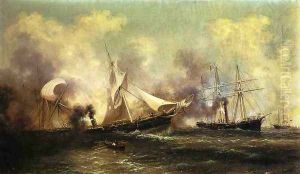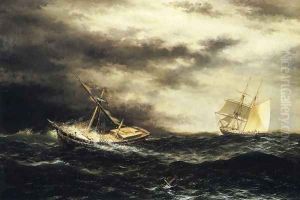Xanthus Russel Smith Paintings
Xanthus Russel Smith was an American marine and landscape painter, born on February 26, 1839, in Philadelphia, Pennsylvania. He was part of a family that greatly valued art and education, which naturally cultivated his early interest in painting. Smith showed an affinity for the arts from a young age, encouraged by his artistic family background. His father, John Jay Smith, was a librarian and amateur artist, providing a nurturing environment for his talents.
Smith pursued formal art education under the guidance of notable artists of the time. He studied with Edward Moran, a prominent marine painter, which significantly influenced his choice of subjects in his later works. Smith's early career was marked by his fascination with the sea and naval battles, a passion that was further fueled by the outbreak of the American Civil War.
During the Civil War, Smith served in the Union Navy, an experience that provided him with firsthand knowledge of the ships and battle scenes he would later depict in his art. His service not only deepened his understanding of naval architecture and the sea but also gave him a trove of dramatic scenes to capture in his paintings. After the war, he dedicated himself to his art, becoming well-known for his detailed and accurate representations of naval battles and marine landscapes.
Smith's works are characterized by their meticulous detail, vibrant realism, and historical accuracy. He became a sought-after artist for Civil War enthusiasts and collectors, contributing significantly to the visual documentation of the war's naval history. Beyond his marine and battle scenes, Smith also explored tranquil landscapes and seascapes, demonstrating his versatility as an artist.
Throughout his career, Xanthus Russel Smith exhibited his works in various prestigious venues, including the Pennsylvania Academy of the Fine Arts and the Boston Art Club. His paintings are now part of several important collections, including those of the Union League of Philadelphia and the Historical Society of Pennsylvania. Smith continued to paint and exhibit his work until his later years, passing away on December 2, 1929, in Glenside, Pennsylvania. His legacy endures through his contributions to American art, particularly in his vivid portrayals of the Civil War at sea.




